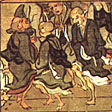|
Two
notable aspects of medieval Japan are the ascendancy of the warrior
class (bushi,
samurai)
and the proliferation of new sects of Buddhism throughout all classes.
While the aristocracy of "Genji's World" still existed and the imperial
court in Kyoto (Heian) was still sovereign in name, the civil wars
of the twelfth century brought to power a warrior government, the bakufu,
that ruled in practice.
First established in Kamakura
in 1192 by the victorious Minamoto
Yoritomo
and later moved to the Muromachi
distict of Kyoto in 1334 by Ashikaga
Takauji,
the bakufu supported certain Buddhist temples while individual priests,
monks, and evangelists spread among the masses new, popularized forms
of Buddhism that had been brought from China during the late Heian
period. |
| Jôdo
(Pure Land) Buddhism,
introduced to Japan in the 1170s by Hônen,
was the principal new faith, along with its variant Jôdo
Shin Shû (True Pure Land Sect)
that was introduced later by Shinran.
The Pure Land sects stressed faith in the tariki
(other
power) of Amida
(Amitabha), the Buddha of Infinite Light. The sincere practice of
the nembutsu--calling
upon Amida's name--would reward the faithful with rebirth into his
Western Paradise of the Pure Land. Evangelists warned the unfaithful
of the horrors of being reborn into lower realms of existence--even
hell. Verbal and visual representations of Buddhist hells were popular
tools of persuasion. Although some warriors were attracted to Pure
Land Buddhism, their generally self-reliant spirit didn't mix well
with dependence on the saving grace of Amida. Instead, many turned
to the self-discipline of Zen
Buddhism,
which also flourished in medieval Japan, inspiring much art.
|
Through
word and image, this Engaging Vision focuses on getting a sense of
Amida Buddhism and the worldview view it preached during the height
of warrior rule in medieval Japan. To begin, click on the dancing
monks:

|